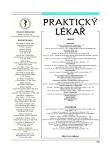Therapeutic protocol of invasive meningococcal disease (IMD) The Therapeutic protocol of invasive meningococcal disease (IMD) is intended for hospital
Léčebný protokol invazivního meningokokového onemocnění (IMO)
Léčebný protokol invazivního meningokokového onemocnění (IMO) je určen pro nemocniční léčbu na infekčních odděleních, dětských odděleních, JIP a lůžkových ARO. Léčení těžkých forem je vhodné provádět ve specializovaných centrech, v nichž je dostupný kompletní diagnostický a léčebný servis. Včasné zahájení léčby je zásadní podmínkou dosažení příznivého klinického výsledku. Oddalování zahájení léčebných postupů do doby přijetí na specializované oddělení je závažnou chybou.
Protokol vznikl v návaznosti na léčebný standard IMO pro přednemocniční neodkladnou péči publikovaný v roce 2002.
Léčebný protokol je uveden charakteristikou klinického obrazu a rozdělením IMO podle klinických forem. Následuje popis iniciální resuscitace dospělých i dětí. Podrobně jsou popsané způsoby diagnostiky, která probíhá paralelně s iniciální resuscitací. Při posouzení celkového stavu se hodnotí i příznaky, které svědčí pro závažný průběh onemocnění. Jejich přítomnost předurčuje nemocného k léčbě na JIP nebo ARO. Prioritou je antibiotická léčba, která musí být zahájena do 30 minut po vyslovení podezření na IMO. Následuje přehled monitorovaných parametrů s uvedením cílových hodnot hemodynamických parametrů. Kromě objemové léčby jsou uvedeny i možnosti farmakologické podpory oběhu, indikace umělé plicní ventilace, indikace kortikosteroidní léčby, možnosti léčby hemokoagulační poruchy, léčba nitrolebeční hypertenze a přehled doplňkové léčby.
Klíčová slova:
invazivní meningokokové onemocnění – IMO – léčebný protokol – nemocniční léčba.
Authors:
E. Kasal; L. Rožnovský; P. Křížová
; O. Džupová; V. Dostál; V. Štruncová; I. Chytra; D. Barnetová; T. Habanec; S. Plíšek; P. Chalupa
Authors‘ workplace:
Hlavní řešitel doc. MUDr. E. Kasal, CSc., přednosta ARK FN Plzeň
; Řešitelská skupina grantu IGA MZ ČR NI-7109-3: Prognostické faktory invazivního meningokokového onemocnění a jejich vliv na
strategii léčby (2002–2004)
Published in:
Prakt. Lék. 2005; 85(4): 196-199
Category:
Various Specialization
Overview
The Therapeutic protocol of invasive meningococcal disease (IMD) is intended for hospital treatment at departments of infectious diseases, pediatric departments, intensive care units and critical care units of departments of anaesthesiology, resuscitation and intensive care. Therapy of severe forms of IMD should be carried out in special centers with complete diagnostic and therapeutic servis available. Timely initiation of therapy is a basic condition for a favorable outcome. Delayed therapy till the moment of admission in a special center is a big mistake. This protocol was developed in extention of the IMD therapeutic protocol for urgent prehospital care published in 2002.
In the introduction of the therapeutic protocol there are described characteristics of the clinical picture and IMD is classified according to its clinical forms. The initial resuscitation of adult and paediatric patients follows. Diagnostic procedures protocol is realized in parallel with initial resuscitation. During assessment of the patient’s general condition it is necessary to evaluate signs typical for severe forms of IMD. Their presence is an indication for admission of the patient to the intensive or critical care unit. Antibiotic therapy introduced within 30 minutes from the first suspicion of IMD represents the basic priority. A review of hemodynamic parameters under monitoring follows with their target values. In addition to volume therapy, possibilities of catecholamin circulatory support, indications for ventilatory support, corticosteroid therapy, possibilities of therapy of emocoagulation disorders, therapy of intracranial hypertension and additional therapeutic procedures are included.
Key words:
invasive meningococcal disease – IMD – therapeutic protocol – hospital treatment.
Labels
General practitioner for children and adolescents General practitioner for adultsArticle was published in
General Practitioner

2005 Issue 4
- Metamizole vs. Tramadol in Postoperative Analgesia
- Metamizole at a Glance and in Practice – Effective Non-Opioid Analgesic for All Ages
- Memantine in Dementia Therapy – Current Findings and Possible Future Applications
- Memantine Eases Daily Life for Patients and Caregivers
- Possibilities of Using Metamizole in the Treatment of Acute Primary Headaches
Most read in this issue
- The aggressive patient
- Benign cutaneous pigmented lesions and the various possibilities in their examination
- Musculoskeletal complaints at work with the computer
- Genetics and ethics – past, present, and future
